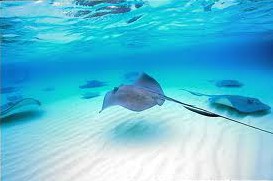
The Cayman Islands is a Caribbean vacation paradise, known for the world-famous Stingray City, a gigantic sandbar with the world’s largest stingray population. Tourists flock to this site to feed and interact with the multitudes of friendly stingrays.
A recent study, however, conducted in March 2013, by The Guy Harvey Research Institute, part of Nova Southeastern University, questioned the effects of so much human interaction on Dasyatis americana, or southern stingrays.
The study showed that the mass human interaction drastically changed the stingrays’ behavior. The stingrays that are fed at Stingray City were active for nearly all of the day. They follow this pattern because the tourists, who supply the stingrays’ with the majority of their food, come to the sandbar during the day.
Wild stingrays are the exact opposite. They forage and feed largely at night, without much activity during the daytime.
The tourism, therefore, is completely reversing stingrays’ feeding and movement patterns.
Another study, conducted in 2009 by Simon Fraser University and Florida International University, found even more detrimental effects of the human interaction with southern stingrays at Stingray City.
Among other effects, this study found that the human interaction at Stingray City caused exposure to unnatural food, higher injury rates, higher parasite loads, and very high levels of stress. Additionally, stingrays at Stingray City were found to be unnaturally friendly around humans and they had a much weaker defense system.
Lisa Wu, a marine biology teacher, has some personal experience with stingrays. For 10 years, Wu volunteered at the Baltimore National Aquarium. She had a lot of interaction with the stingrays and was a diver who swam with the stingrays in front of an audience, to demonstrate feeding and other behavior and characteristics of the animals.
“They were so used to being fed that they had no problem vacuuming up the side of your wetsuit to get to the food in your hand,” Wu said. “I felt like a meatball in a bowl of spaghetti.”
Wu believes that if the stingrays in the Baltimore National Aquarium, or those in Stingray City, were released into the wild, they would be too dependent on humans.
An example of another world renowned wildlife habitat that has taken the effects of human interaction on wildlife much more seriously is the Galapagos Islands, off the coast of Ecuador.
In the Galapagos, there are strict laws prohibiting touching, feeding, and harassment of all wildlife. Also, disturbing the ecosystem in any way, even taking a rock home as a souvenir, is forbidden.
“They were definitely very concerned about the wildlife,” said Alexis Williams, a sophomore here at Jefferson who went to the Galapagos during Spring Break last year. “There was a guide with us all the time, to make sure we didn’t disturb the wildlife in any way.
Wu believes that the Galapagos and the Cayman Islands are two very different environments, a wildlife preserve and a tourism site, and laws regarding human interaction with the animals should be different in each.
Wu does believe, however, that the harmfulness of human interaction with the wildlife should be thoroughly assessed before it is allowed, no matter the location.
“Any time there are plans to have a site where people are regularly interacting with animals, there needs to be scientific studies conducted to develop the guidelines that would be necessary for the safety of the animals, as well as the humans.”

